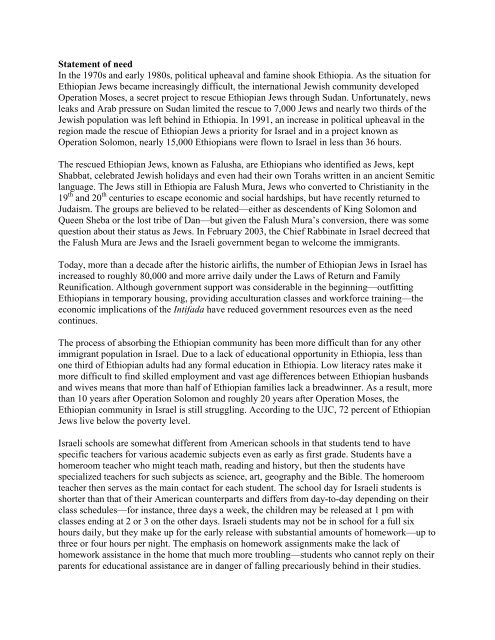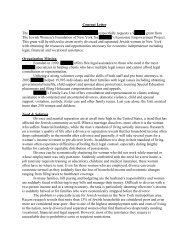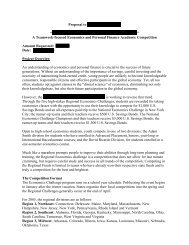The Elie Wiesel Foundation for Humanity Proposal to FOUNDATION ...
The Elie Wiesel Foundation for Humanity Proposal to FOUNDATION ...
The Elie Wiesel Foundation for Humanity Proposal to FOUNDATION ...
You also want an ePaper? Increase the reach of your titles
YUMPU automatically turns print PDFs into web optimized ePapers that Google loves.
Statement of need<br />
In the 1970s and early 1980s, political upheaval and famine shook Ethiopia. As the situation <strong>for</strong><br />
Ethiopian Jews became increasingly difficult, the international Jewish community developed<br />
Operation Moses, a secret project <strong>to</strong> rescue Ethiopian Jews through Sudan. Un<strong>for</strong>tunately, news<br />
leaks and Arab pressure on Sudan limited the rescue <strong>to</strong> 7,000 Jews and nearly two thirds of the<br />
Jewish population was left behind in Ethiopia. In 1991, an increase in political upheaval in the<br />
region made the rescue of Ethiopian Jews a priority <strong>for</strong> Israel and in a project known as<br />
Operation Solomon, nearly 15,000 Ethiopians were flown <strong>to</strong> Israel in less than 36 hours.<br />
<strong>The</strong> rescued Ethiopian Jews, known as Falusha, are Ethiopians who identified as Jews, kept<br />
Shabbat, celebrated Jewish holidays and even had their own Torahs written in an ancient Semitic<br />
language. <strong>The</strong> Jews still in Ethiopia are Falush Mura, Jews who converted <strong>to</strong> Christianity in the<br />
19 th and 20 th centuries <strong>to</strong> escape economic and social hardships, but have recently returned <strong>to</strong><br />
Judaism. <strong>The</strong> groups are believed <strong>to</strong> be related—either as descendents of King Solomon and<br />
Queen Sheba or the lost tribe of Dan—but given the Falush Mura’s conversion, there was some<br />
question about their status as Jews. In February 2003, the Chief Rabbinate in Israel decreed that<br />
the Falush Mura are Jews and the Israeli government began <strong>to</strong> welcome the immigrants.<br />
Today, more than a decade after the his<strong>to</strong>ric airlifts, the number of Ethiopian Jews in Israel has<br />
increased <strong>to</strong> roughly 80,000 and more arrive daily under the Laws of Return and Family<br />
Reunification. Although government support was considerable in the beginning—outfitting<br />
Ethiopians in temporary housing, providing acculturation classes and work<strong>for</strong>ce training—the<br />
economic implications of the Intifada have reduced government resources even as the need<br />
continues.<br />
<strong>The</strong> process of absorbing the Ethiopian community has been more difficult than <strong>for</strong> any other<br />
immigrant population in Israel. Due <strong>to</strong> a lack of educational opportunity in Ethiopia, less than<br />
one third of Ethiopian adults had any <strong>for</strong>mal education in Ethiopia. Low literacy rates make it<br />
more difficult <strong>to</strong> find skilled employment and vast age differences between Ethiopian husbands<br />
and wives means that more than half of Ethiopian families lack a breadwinner. As a result, more<br />
than 10 years after Operation Solomon and roughly 20 years after Operation Moses, the<br />
Ethiopian community in Israel is still struggling. According <strong>to</strong> the UJC, 72 percent of Ethiopian<br />
Jews live below the poverty level.<br />
Israeli schools are somewhat different from American schools in that students tend <strong>to</strong> have<br />
specific teachers <strong>for</strong> various academic subjects even as early as first grade. Students have a<br />
homeroom teacher who might teach math, reading and his<strong>to</strong>ry, but then the students have<br />
specialized teachers <strong>for</strong> such subjects as science, art, geography and the Bible. <strong>The</strong> homeroom<br />
teacher then serves as the main contact <strong>for</strong> each student. <strong>The</strong> school day <strong>for</strong> Israeli students is<br />
shorter than that of their American counterparts and differs from day-<strong>to</strong>-day depending on their<br />
class schedules—<strong>for</strong> instance, three days a week, the children may be released at 1 pm with<br />
classes ending at 2 or 3 on the other days. Israeli students may not be in school <strong>for</strong> a full six<br />
hours daily, but they make up <strong>for</strong> the early release with substantial amounts of homework—up <strong>to</strong><br />
three or four hours per night. <strong>The</strong> emphasis on homework assignments make the lack of<br />
homework assistance in the home that much more troubling—students who cannot reply on their<br />
parents <strong>for</strong> educational assistance are in danger of falling precariously behind in their studies.




